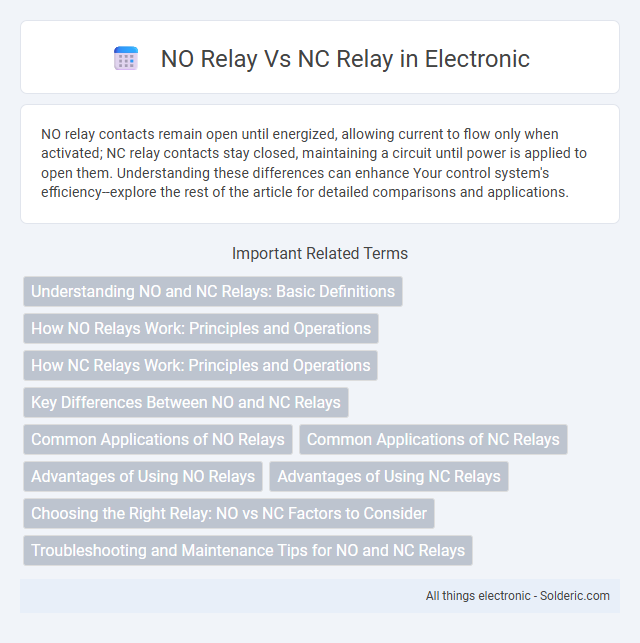NO relay contacts remain open until energized, allowing current to flow only when activated; NC relay contacts stay closed, maintaining a circuit until power is applied to open them. Understanding these differences can enhance Your control system's efficiency--explore the rest of the article for detailed comparisons and applications.
Comparison Table
| Feature | NO Relay (Normally Open) | NC Relay (Normally Closed) |
|---|---|---|
| Default State | Contacts open, no current flow | Contacts closed, current flows |
| Operation | Closes contacts when energized | Opens contacts when energized |
| Typical Use | Activate circuits on demand | Interrupt circuits during activation |
| Fail-Safe Behavior | No connection if power lost | Maintains circuit connection if power lost |
| Applications | Lighting control, motor starters | Emergency stop, safety interlocks |
| Symbol | Open contact line | Closed contact line |
Understanding NO and NC Relays: Basic Definitions
NO relay (Normally Open) contacts remain open when the relay coil is de-energized, only closing the circuit when the coil is powered, making it ideal for applications where you want current to flow only during activation. NC relay (Normally Closed) contacts are closed in their default state, allowing current to pass until the relay coil is energized, which then opens the circuit to stop current flow. Understanding these basic definitions helps Your choice of relay align with the intended control logic in electrical systems.
How NO Relays Work: Principles and Operations
NO relays (Normally Open relays) operate by keeping their contacts open when the coil is de-energized, preventing current flow through the circuit. When the coil receives an electrical signal, it generates a magnetic field that pulls the contacts together, closing the circuit and allowing current to pass. This switching mechanism enables NO relays to control devices or signal circuits only when activated, making them ideal for applications requiring a default off state.
How NC Relays Work: Principles and Operations
NC relays operate by maintaining a closed circuit in their default state, allowing current to flow continuously until the relay coil is energized. When voltage is applied to the coil, the electromagnetic force pulls the armature, breaking the circuit and opening the contacts to stop the current flow. This normally closed configuration is essential for fail-safe applications where uninterrupted power or signal flow is critical unless intentionally interrupted.
Key Differences Between NO and NC Relays
NO (Normally Open) relays remain open when de-energized, allowing no current flow, and close to complete the circuit when energized; NC (Normally Closed) relays are closed by default, enabling current flow until energized to open the circuit. The primary difference lies in their default state and switching behavior, impacting their use in fail-safe or control applications. NO relays are commonly employed where activation triggers circuit closure, while NC relays are preferred for default-on monitoring or emergency shutdown systems.
Common Applications of NO Relays
NO (Normally Open) relays are widely utilized in common applications such as controlling lighting systems, activating alarms, and managing motor starters, where the circuit is completed only when the relay is energized. These relays are ideal for situations requiring an automatic switch-on mechanism, ensuring that devices remain off until your command triggers the circuit closure. Their reliable performance in automation systems and control panels supports efficient operation and safety in various industrial and residential setups.
Common Applications of NC Relays
NC relays are commonly used in safety and emergency systems where devices must remain powered or active without external input, such as fire alarm circuits, emergency stop buttons, and fail-safe industrial machinery. Your system benefits from NC relays by ensuring continuous operation or immediate response when power supply is interrupted or a fault occurs. These relays provide reliable default circuit closure, crucial in critical control and protection applications.
Advantages of Using NO Relays
NO relays offer significant advantages in safety-critical applications by defaulting to an off state, reducing the risk of unintended activation. Their simple wiring and straightforward control logic enhance system reliability and ease of troubleshooting. You benefit from energy efficiency since NO relays only consume power when switched on, optimizing overall operational cost.
Advantages of Using NC Relays
NC relays provide continuous circuit connectivity, ensuring your system remains operational during power failures or control signal loss, which enhances overall safety and reliability. Their default closed state prevents unintended interruptions, making them ideal for fail-safe applications and critical load protection. Utilizing NC relays reduces downtime risk in emergency systems and industrial controls by maintaining essential connections without constant power.
Choosing the Right Relay: NO vs NC Factors to Consider
Choosing the right relay involves understanding the operational differences between Normally Open (NO) and Normally Closed (NC) contacts. NO relays are ideal for applications where the circuit is activated only when the relay coil is energized, making them suitable for momentary controls and safety interlocks. NC relays maintain a closed circuit when de-energized, ensuring fail-safe operation in critical systems, so your selection should consider the desired default state, load requirements, and safety protocols.
Troubleshooting and Maintenance Tips for NO and NC Relays
When troubleshooting NO (Normally Open) and NC (Normally Closed) relays, first verify the coil voltage and ensure proper contact operation using a multimeter to detect continuity changes during activation. Regular maintenance involves cleaning contact surfaces to prevent oxidation and checking for signs of wear or pitting that could impair relay performance. Your proactive inspection and timely replacement of faulty relays will minimize downtime and improve system reliability.
NO relay vs NC relay Infographic

 solderic.com
solderic.com